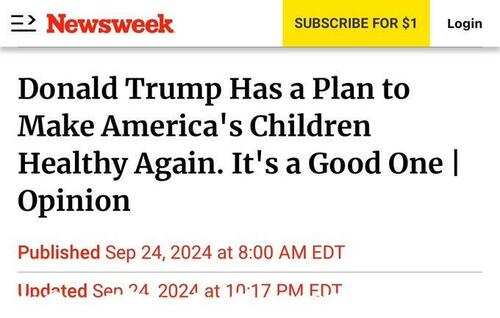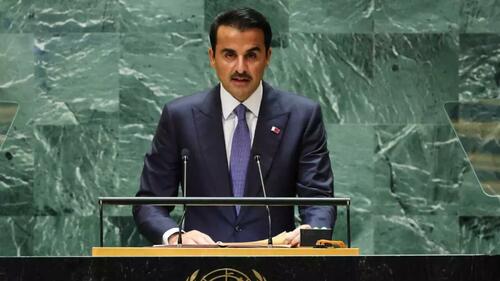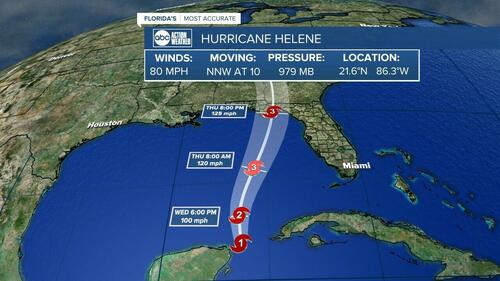Authored by Kit Knightly via Off-Guardian.org,
The United Nation’s Summit of the Future is over. The “great and good” of global leadership got together for four days in New York for what their website called…
a once-in-a-generation opportunity to reimagine the multilateral system and steer humanity on a new course
…which sounds just lovely and not at all creepy and hubristic.

The four day event was split into two “action days” and two days of “the Summit.”
Both of which are just different names for “people in suits sitting around big tables using bureaucratic jargon while making big time serious important-person faces”.
The result of which is the passing of a document they’re calling the “Pact for the Future” – 81 pages of self-important waffle so crammed with meaningless political language it becomes near-unintelligible (what James Corbett calls “Globalese”).
Here’s a paragraph chosen at random:
Enhancing cooperation with stakeholders, including civil society, academia, the scientific and technological community and the private sector, and encouraging intergenerational partnerships, by promoting a whole-of society approach, to share best practices and develop innovative, long-term and forward-thinking ideas in order to safeguard the needs and interests of future generations.
…it’s all like that. And I read it all. 81 pages.
You’re welcome.
In terms of real content, there are no new ideas here. We have seen this globalist shopping list of alleged “issues” before.
Climate change, conflict, food insecurity, poverty, misinformation, hate speech. The usual “problems” that collectively form what the document refers to as “complex global shocks”.
These “shocks” – the document tells us – can be addressed with a series of “solutions” that are again no surprise:
“respect for international law”,
“expanded cooperation”,
“increased role for the UN” and the post-covid buzzword of choice –
“interoperability”.
All of which can be broadly defined as our old friend “global government”.
As you’d expect, there’s a lot of talk about money and finance (massive transfers of public money into private hands is how you win over corporations and hedge funds to your authoritarian cause, after all). For example Action 9(28)(f) promises…
…a new collective quantified goal from a floor of 100 billion United States dollars per year, taking into account the needs and priorities of developing countries [to combat climate change];
$100 billion per year. You can buy a lot of ScienceTM with that.
The most blatantly authoritarian language is reserved for control of the internet (it almost always is), and Objectives 3 & 4 of the “Global Digital Compact Annex” are two of the few that require little to no translation at all, pledging to:
Foster an inclusive, open, safe and secure digital space that respects, protects and promotes human rights [and] Advance responsible, equitable and interoperable data governance approaches
The annex goes on to underline the importance of “Information Integrity” [emphasis added]:
33. Access to relevant, reliable and accurate information and knowledge is essential for an inclusive, open, safe and secure digital space. [T]echnolog[y] can facilitate the manipulation of and interference with information in ways that are harmful to societies and individuals, and negatively affect the enjoyment of human rights and fundamental freedoms as well as the attainment of the Sustainable Development Goals.
34.We will work together to promote information integrity, tolerance and respect in the digital space, as well as to protect the integrity of democratic processes. We will strengthen international cooperation to address the challenge of misinformation and disinformation and hate speech
And charges digital technology companies to hand over private information to government researchers so they can “address misinformation”:
We urgently call on digital technology companies and social media platforms to enhance the transparency and accountability of their systems [and] provide researchers access to data […] to build an evidence base on how to address misinformation and disinformation and hate speech that can inform government and industry policies, standards and best practices…
That means censorship and surveillance. Just in case that wasn’t clear.
Oh and this?
We commit, by 2030 to: Design and roll out digital media and information literacy curricula to ensure that all users have the skills and knowledge to safely and critically interact with content and with information providers and to enhance resilience against the harmful impacts of misinformation and disinformation
This means brainwashing.
Highly predictable, and very unpleasant, but as I said, none of this is new.
New ideas are not the role of Summits and Pacts, their role is to reinforce the old ideas. The hard-coded assumptions upon which the political class operate.
To shape consensus.
And that’s just what the Pact of the Future did – the pact itself was passed without a vote. Why was it passed without a vote? Because two years ago UN Resolution A/RES/76/307 agreed in advance…
that the Summit will adopt a concise, action-oriented outcome document entitled “A Pact for the Future”, agreed in advance by consensus through intergovernmental negotiations
Rendering Russia’s last minute objections – backed by Sudan, Syria, Iran, Belarus and Nicaragua – entirely pointless, if not entirely performative.
Nevertheless, they warrant examination.
In his statement to the UN on September 22nd, Russia’s Deputy Foreign Minister Sergey Vershinin claimed:
From the very outset, those who coordinated the work on the draft included in it only what was dictated to them mainly by Western countries. The points of contention piled up and were never resolved. None of our requests to sit down at the negotiating table and discuss them were met. This is not what is considered and called multilateralism, which many like to speechify about.
In his trademark eloquent style, Sergei Lavrov remarked:
The future of our peoples cannot be invented in a test tube with the participation of the UN Secretariat and Western lobbyists. It is important to shape a decision on this matter in the conditions of negotiations and achieve a balance of interests,”
Any kind of dissent on the matter of multilateralism – especially re: climate change the social media – represents an uncharacteristic break in the trend of total global harmony on these issues.
Does this represent a genuine split in the global support for “the great reset”?
Well, it’s possible, and we can all hope so, but let’s not oversell it. We know Russia endorses virtually every aspect of the Great Reset – the notion of anthropogenic climate change, Agenda 2030, censorship, CBDCs, digital identity and…well, all of what can be called the globalist agenda.
Their objections here don’t seem to represent any change in that. They don’t appear to be objecting to any of these specific policies. They are raising issues of consultation and national sovereignty, procedure and influence, rather than rejection of the founding myths of the pact.
These are valid of course. Let’s not minimise them.
But do they amount to a rejection of globalist values?
Is this Russia saying no to the Great Reset, or saying it wants to implement the GR on its own terms?
Would the latter represent any kind of victory or benefit for ordinary Russian people?
Is this standing for a point of principal? Or is it jockeying for position in the multipolar world order? In that context, China’s silence would be noteworthy, wouldn’t it.
Or, more cynically, should these objections be read with the same scepticism as the extravagant promises made by opposition leaders who know they will never get in to power and therefore never have to stand by their own words?
After all, the Russians know their objections don’t carry much practical weight because they already signed up to the deal before the fact, making any demurrals purely token at this point. At best this has to be seen as an act of insane naiveté on Russia’s part. Another self-defeating act in a recent history of self-defeating acts.
A note for Russia going forward has to be that agreeing to support a document that hasn’t been written yet no matter what it says is maybe not the brightest idea.
But, however you parse these last minute objections, they are dust in the wind, because the pact is now official.
Every country in the world (yes even the ones that raised objections) now formally agrees that hate speech and misinformation are the problem.
Every country in the world (even the ones that raised objections) endorses an end to privacy and increased censorship as a solution.
Every country in the world (all of them) agrees to spend at least $100 billion per year to pursue “sustainable development goals” in developing nations.
And even those who objected were not dissenting on these policies. Indeed they have endorsed these policies many times.
Just to be absolutely clear here –
There is not one voice in the room actually standing up for reality.
We may not have a formal global government yet, but we already have a globalism of ideas, even if there is some disagreement over implementation.
That’s how world government is being shaped, and how it will get finally born – through a creeping consensus of fictitious problems & needless and often insane “solutions” quietly endorsed by every nation of the world.











